Succulent gardens are the perfect fusion of low-maintenance care and high-impact design, offering endless possibilities for indoor and outdoor spaces. From compact container arrangements to sweeping landscape installations, succulents bring texture, color, and sculptural form to any setting. Whether you’re working with limited square footage or a sprawling yard, you can tailor succulent displays to suit vertical walls, hanging baskets, miniature fairy worlds, or even mosaic art. Their drought tolerance makes them ideal for sustainable gardening, while their diverse shapes—from rosette-forming echeverias to trailing string-of-pearls—provide dynamic visual interest. Below are 20 creative succulent garden ideas, each offering a unique way to celebrate these striking, water-wise plants.
1. Container Succulent Gardens
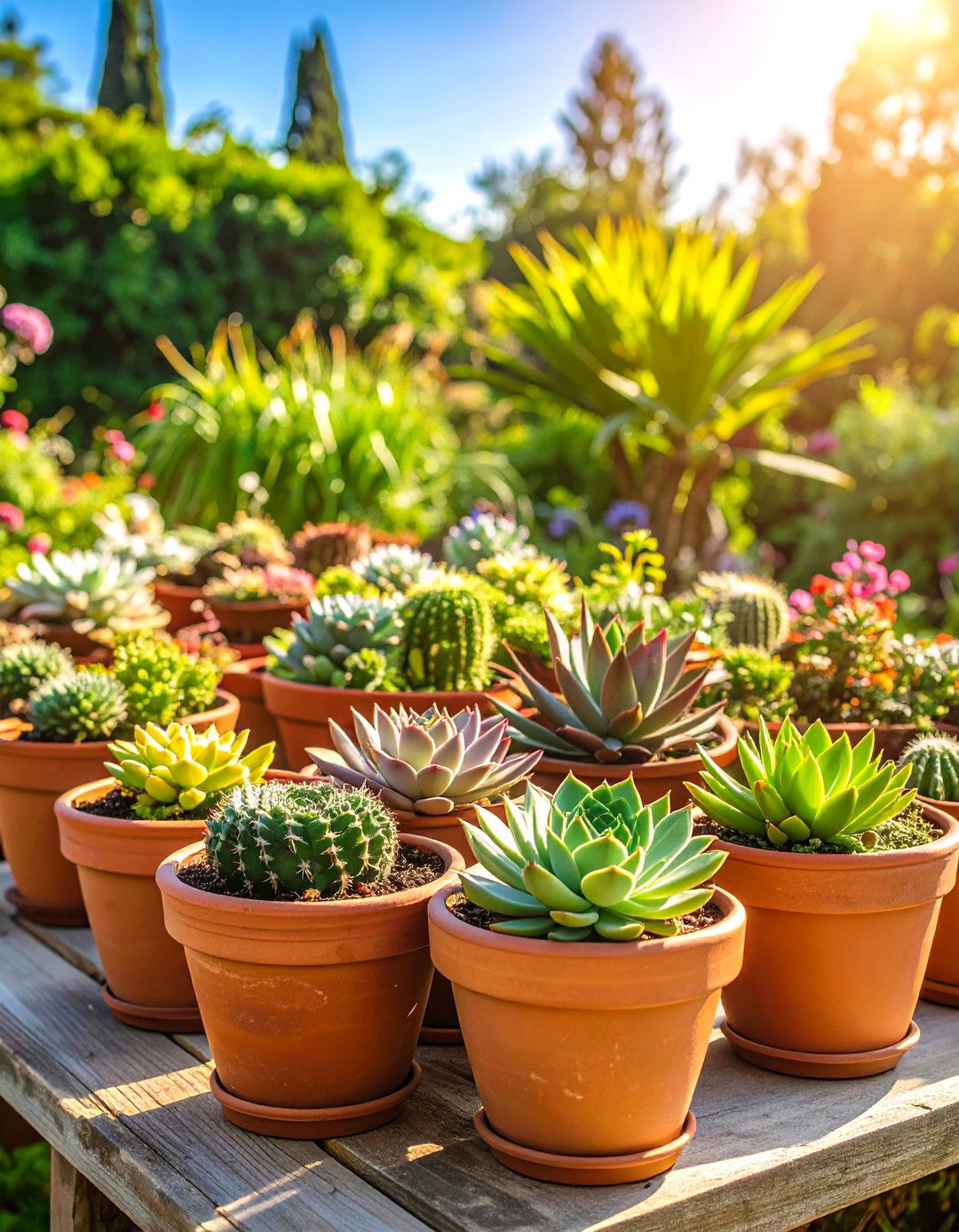
Container gardens are among the simplest and most versatile ways to showcase succulents, allowing you to mix species by color, form, and water needs in any vessel with drainage. Grouping succulents with similar light and moisture requirements ensures harmonious growth and simplifies care. Popular containers include terracotta pots, glazed ceramic bowls, or even repurposed items like wooden crates. By varying heights and textures—pairing tall agave with low-growing sedum—you create depth and visual rhythm. Containers can be switched seasonally, offering fresh arrangements for patios, balconies, or indoor tabletops.
2. Vertical Succulent Walls
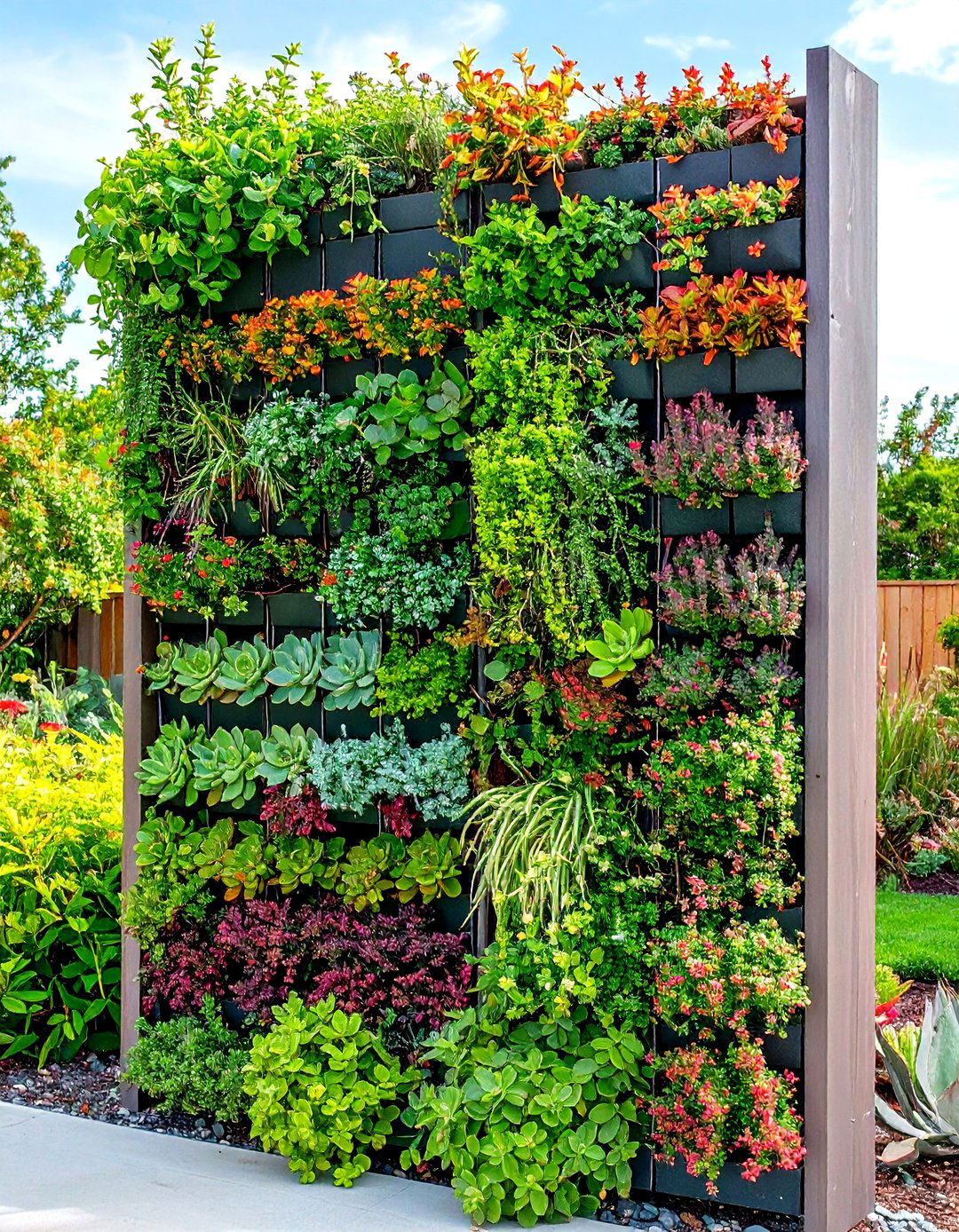
Vertical gardens transform blank walls into living tapestries, making them perfect for small spaces or accent pieces in offices and living rooms. Professionally installed frames hold pockets of soil and plants, while DIY options use repurposed gutters or pocket planters. Succulents such as sempervivums, sedums, and echeverias thrive when embedded into felt or wire mesh panels. These walls improve acoustics and air quality, and the modular panels allow easy replacement of individual plants. Over time, trailing varieties like sedum morganianum spill over the edges, softening the structure and adding cascading interest.
3. Succulent Dish Gardens
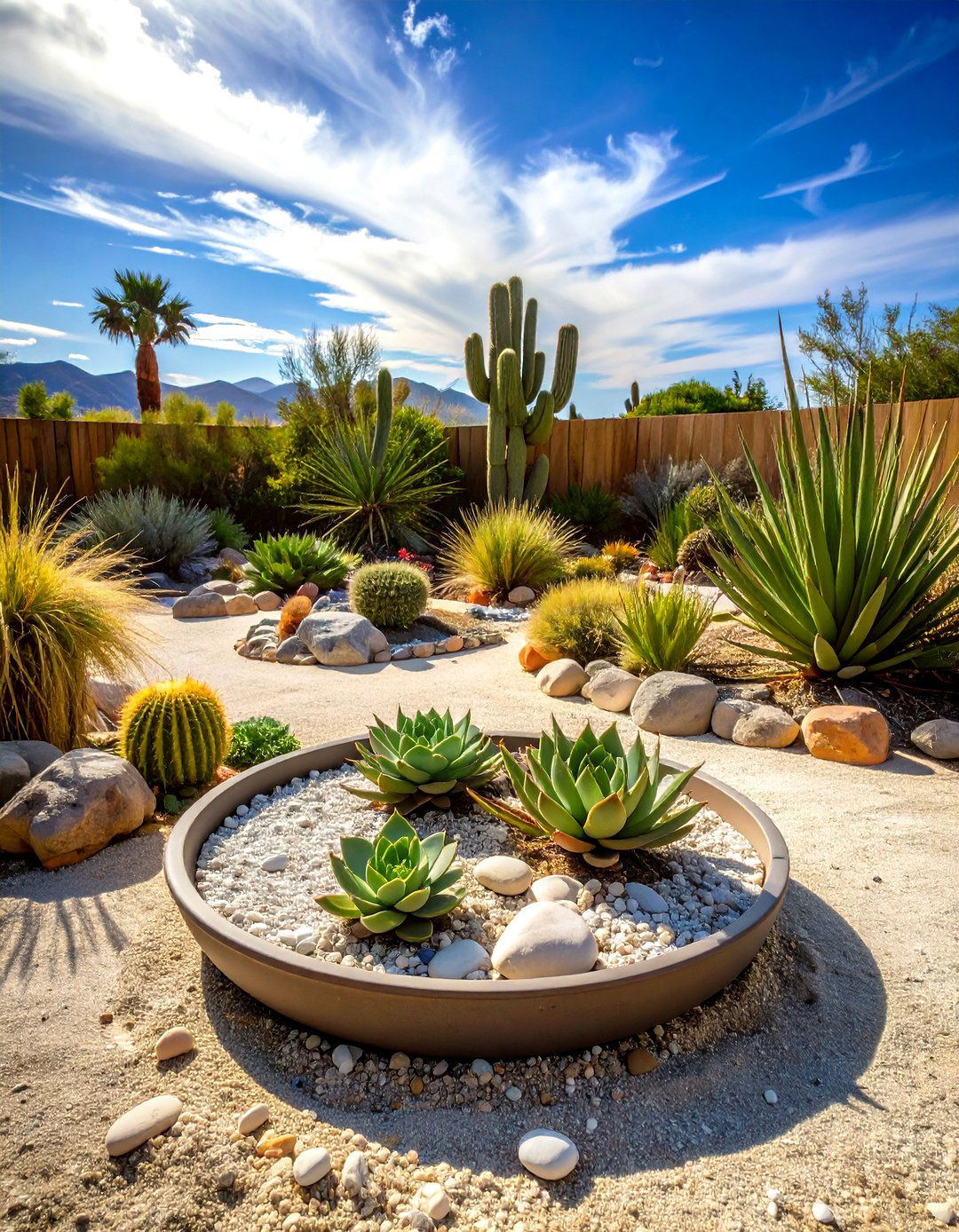
Dish gardens feature shallow containers filled with a variety of miniature succulents to mimic landscapes or thematic scenes. By layering gravel, charcoal, and well-draining soil, and strategically placing rocks or driftwood, you can create desert vignettes or moss-lined fairy realms. Common plants include haworthias, small echeverias, and lithops “living stones.” Since these setups are compact, they make excellent centerpieces and gifts. Position them near bright windows and water sparingly—only when the soil is completely dry—to prevent rot and ensure longevity.
4. Hanging Succulent Planters
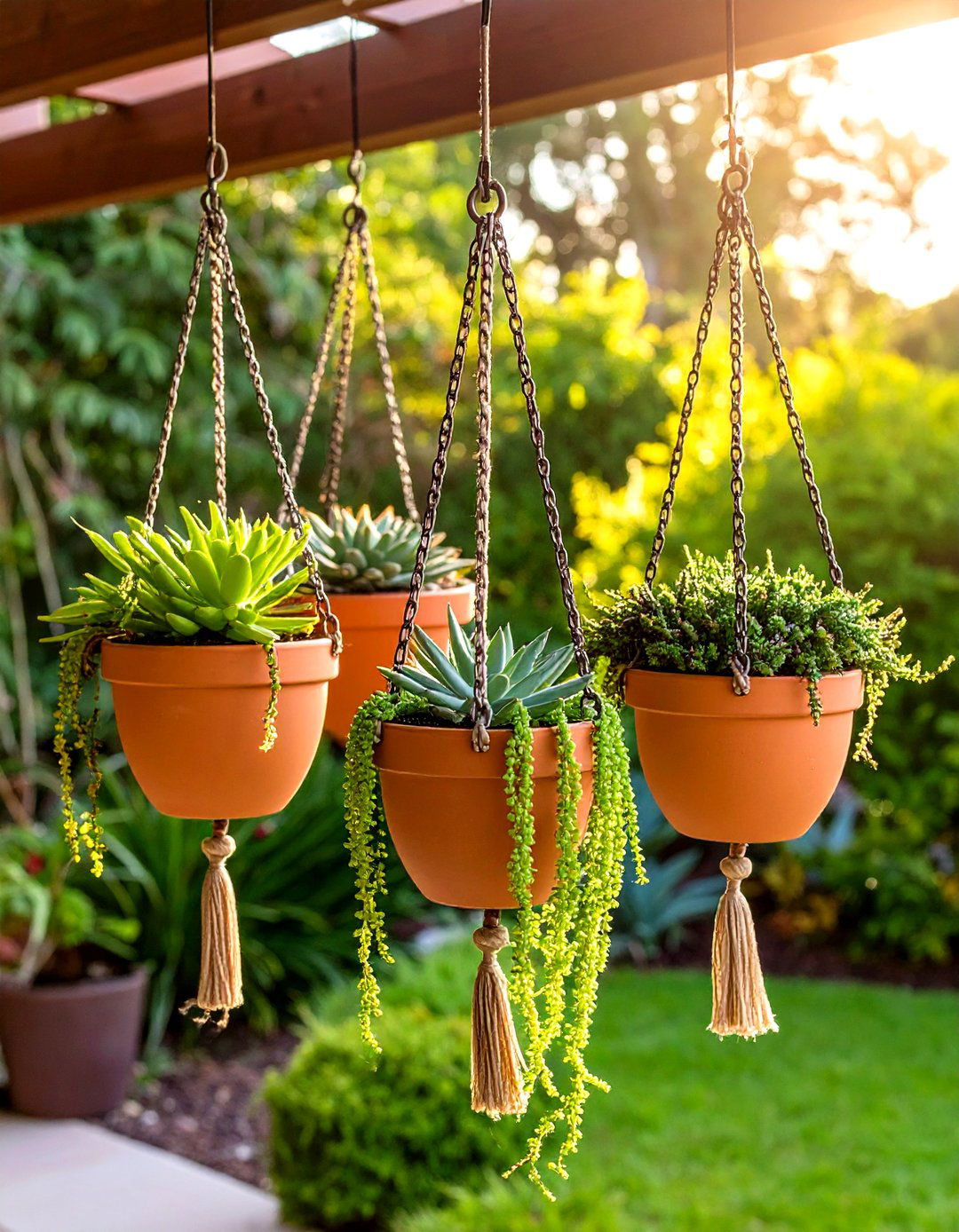
Hanging planters free up tabletop space and draw the eye upward, making them ideal for balconies or sunrooms. Options include macramé hangers cradling resin pots or ceramic planters suspended by chains. Best plants for hanging displays are trailing types like string-of-pearls (Senecio rowleyanus), burro’s tail (Sedum morganianum), and spiderwort varieties. Ensure hanging planters have ample drainage and are rotated periodically for even sun exposure. These aerial gardens add movement and softness to vertical surfaces, especially when interspersed with air plants or lightweight ferns.
5. Succulent Terrariums
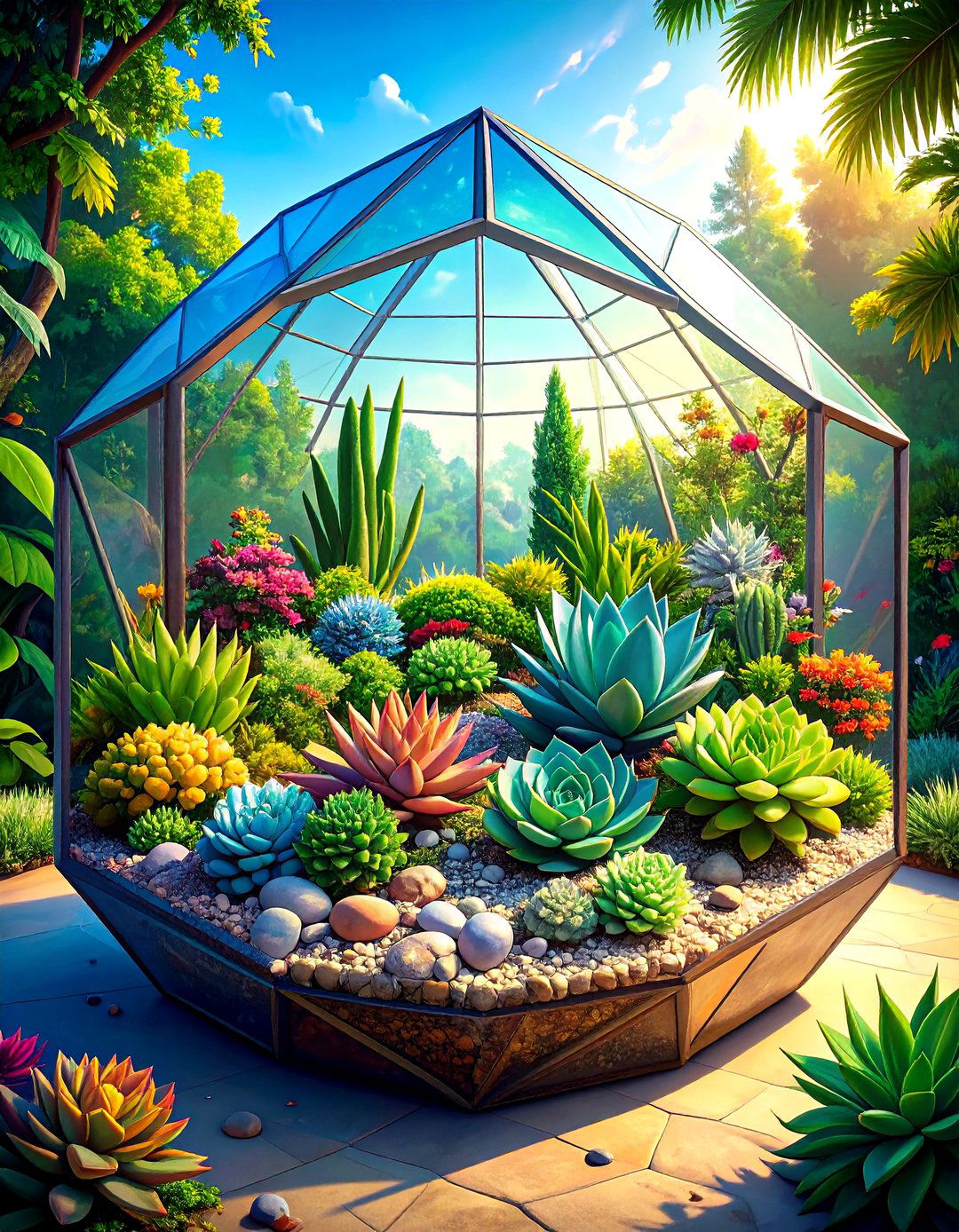
Terrariums showcase succulents in glass vessels, from geometric jars to traditional fish bowls, creating controlled microclimates. Begin with a layer of pebbles for drainage, followed by activated charcoal to prevent odors, then succulent potting mix. Use small-scale succulents like haworthias, gasterias, and dwarf echeverias, avoiding taller species that outgrow the container. Add decorative elements—miniature figurines, colored sand, or stones—to personalize the scene. Terrariums require bright, indirect light and only occasional misting to maintain humidity, making them ideal low-stress décor for desks and shelves.
6. Succulent Fairy Gardens
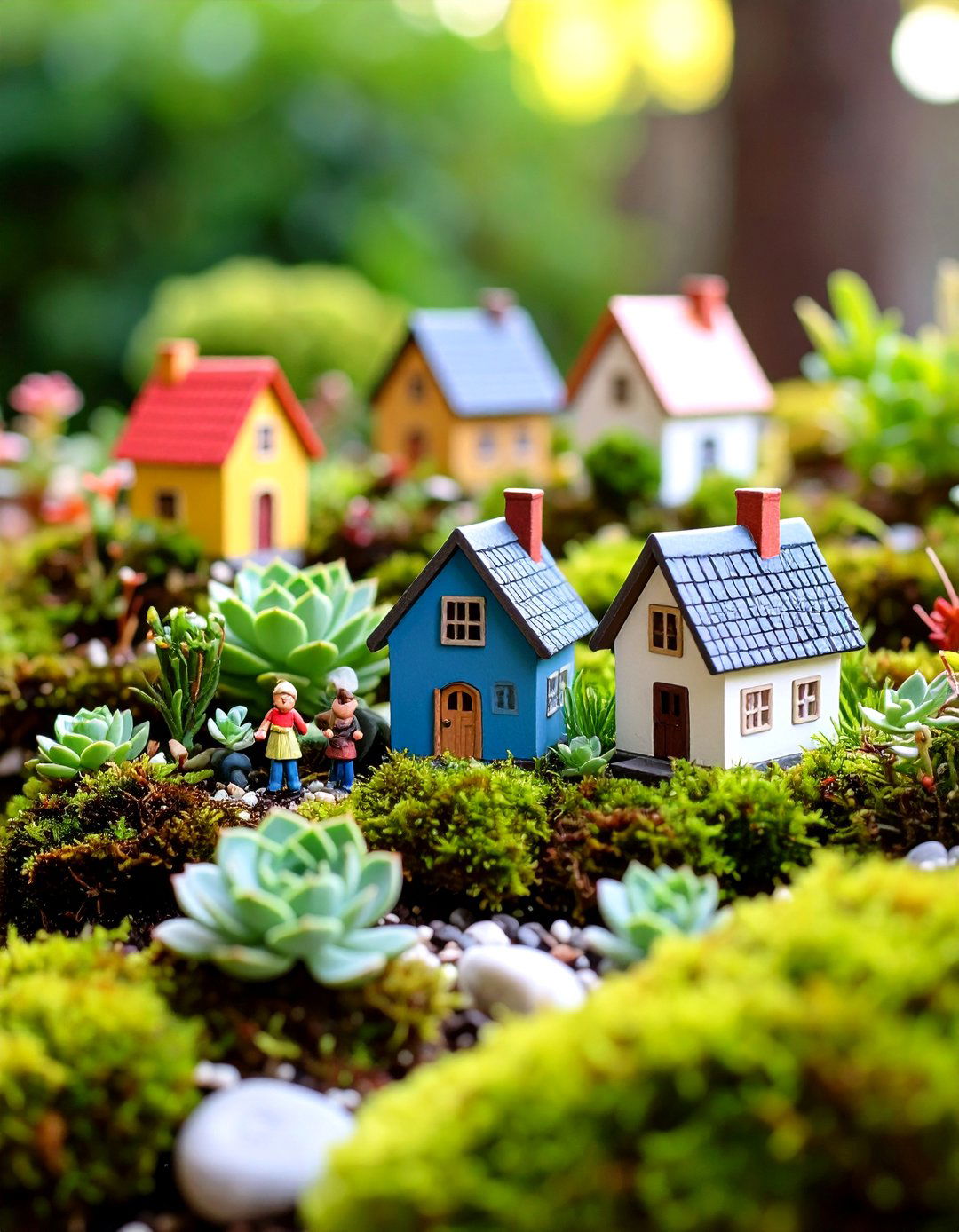
Fairy gardens combine succulents with miniature accessories—tiny houses, bridges, and figurines—to create enchanting, storybook landscapes. Use tiered planters or shallow troughs to establish levels, then fill with sand and succulent soil. Popular plant choices include small sempervivums, sedums, and crassulas. Add moss, pebbles, and miniature tools for scale. These whimsical arrangements are perfect for engaging children in gardening and can be displayed on patios or indoors near sunny windows. Succulent fairy gardens are highly customizable, evolving with new décor and plant additions.
7. Succulent Wreaths

Living wreaths crafted from succulent cuttings offer a fresh twist on door décor. A sphagnum-moss wreath form is soaked, then packed with cuttings of sedum, echeveria, and aeonium. Secure stems with floral pins, arranging larger rosettes first, followed by filler varieties for density. After six weeks, roots anchor the plants, allowing you to hang the wreath vertically. Water by briefly submerging in a shallow tray every few weeks, and display in bright but indirect light to prevent scorching.
8. Succulent Centerpieces
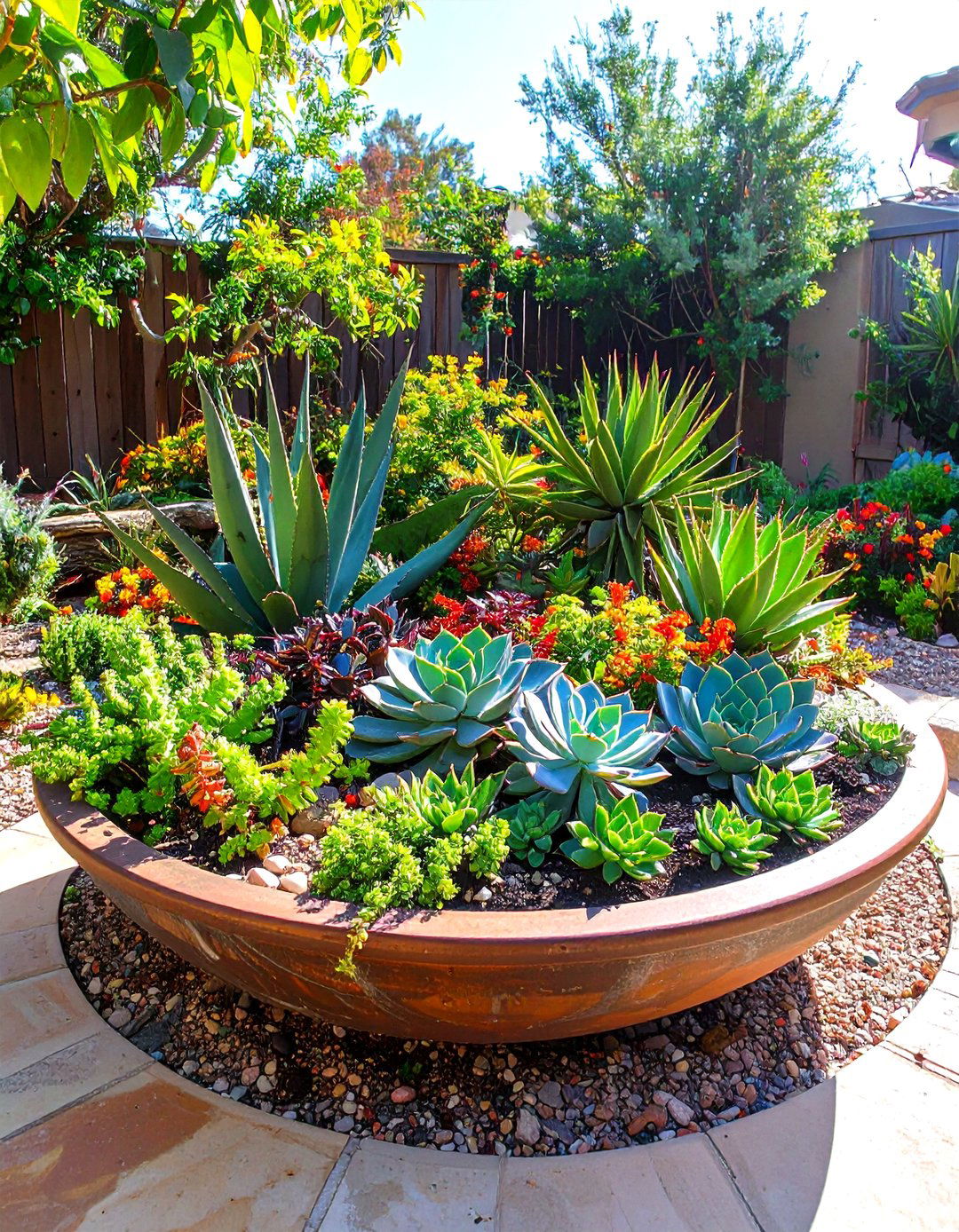
Low, wide bowls filled with a mix of succulents create striking table centerpieces. Combine contrasting shapes—upright agave pups, trailing sedum vines, and rosette echeverias—with ornamental rocks and driftwood. This mixed-media approach adds texture and height variation. Centerpieces can be designed to echo seasonal color palettes, using burgundy-tinged kalanchoe in autumn or pale pastels in spring. Maintain by rotating for even light and watering deeply but infrequently, allowing soil to dry out fully between waterings.
9. Succulent Rock Gardens
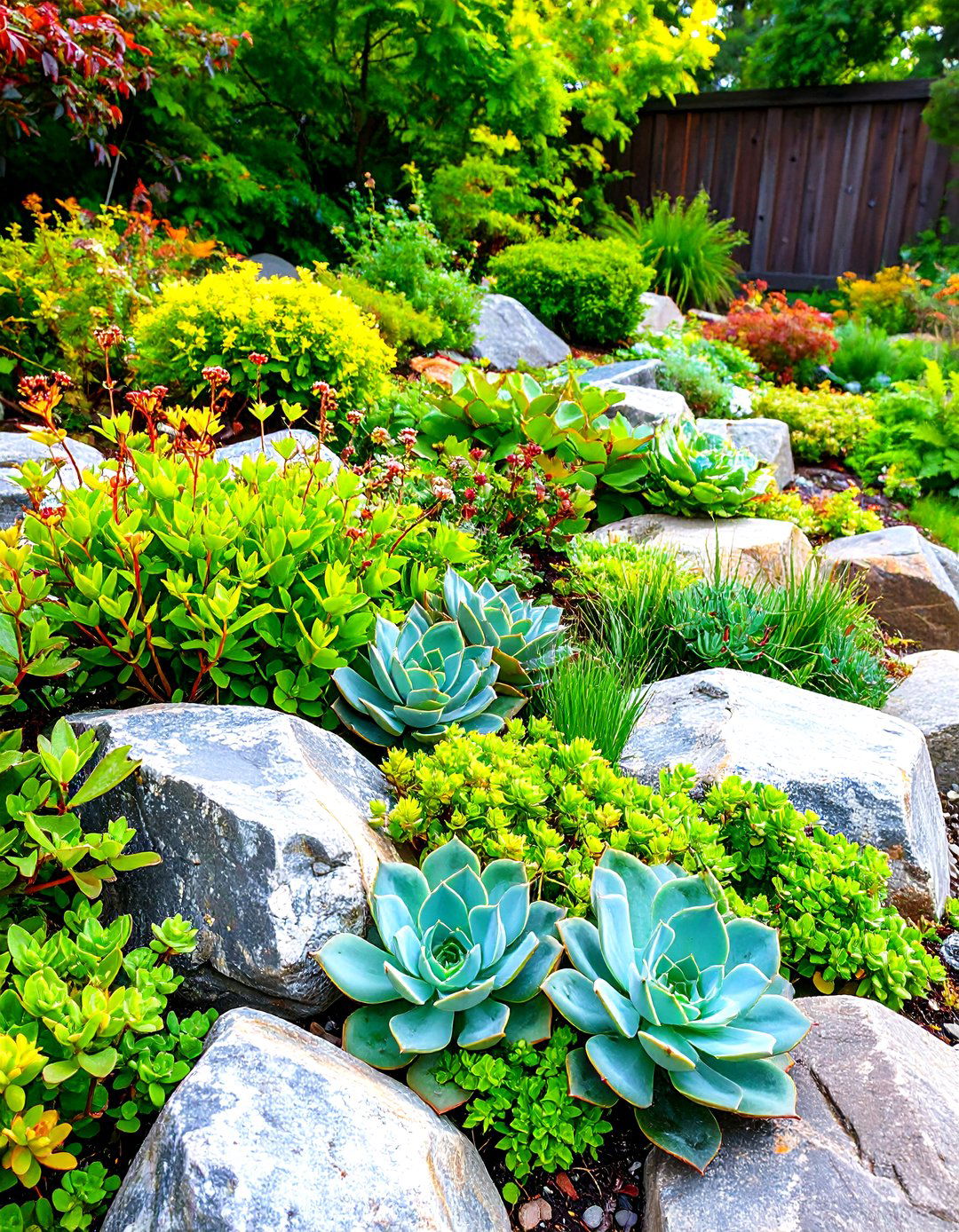
Integrate succulents into rock garden landscapes by planting in crevices and pockets among boulders and gravel beds. Choose hardy outdoor succulents—agaves, sempervivums, and sedums—that withstand temperature fluctuations. Create defined rock perimeters to contain soil and establish tiers for visual interest. Sandy, well-draining soil ensures roots don’t sit in moisture. Over time, creeping groundcovers like sedum fill gaps, softening edges. This Xeriscape approach conserves water while providing year-round structure and color.
10. Succulent Trough Planters
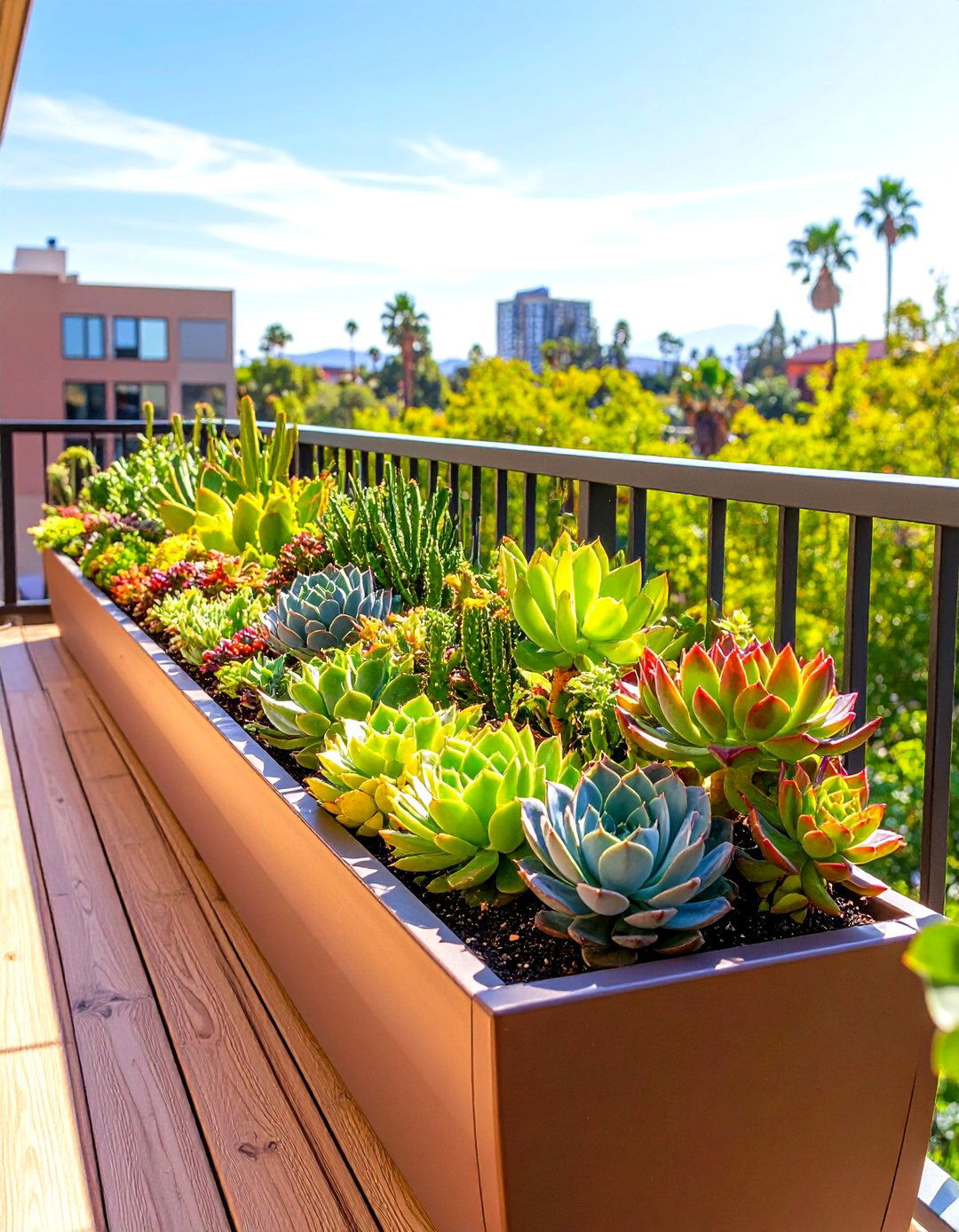
Long troughs—ceramic, concrete, or timber—accommodate linear succulent displays ideal for balconies or window sills. Arrange taller species like sansevieria at the ends, with medium succulents (e.g., crassulas) in the center and trailing varieties spilling over the sides. This layered composition maximizes depth and ensures each plant has adequate room to grow. Trough planters benefit from uniform drainage holes and periodic soil refreshes. They provide a cohesive look when placed in multiples along railings or walls.
11. Succulent Mosaic Art
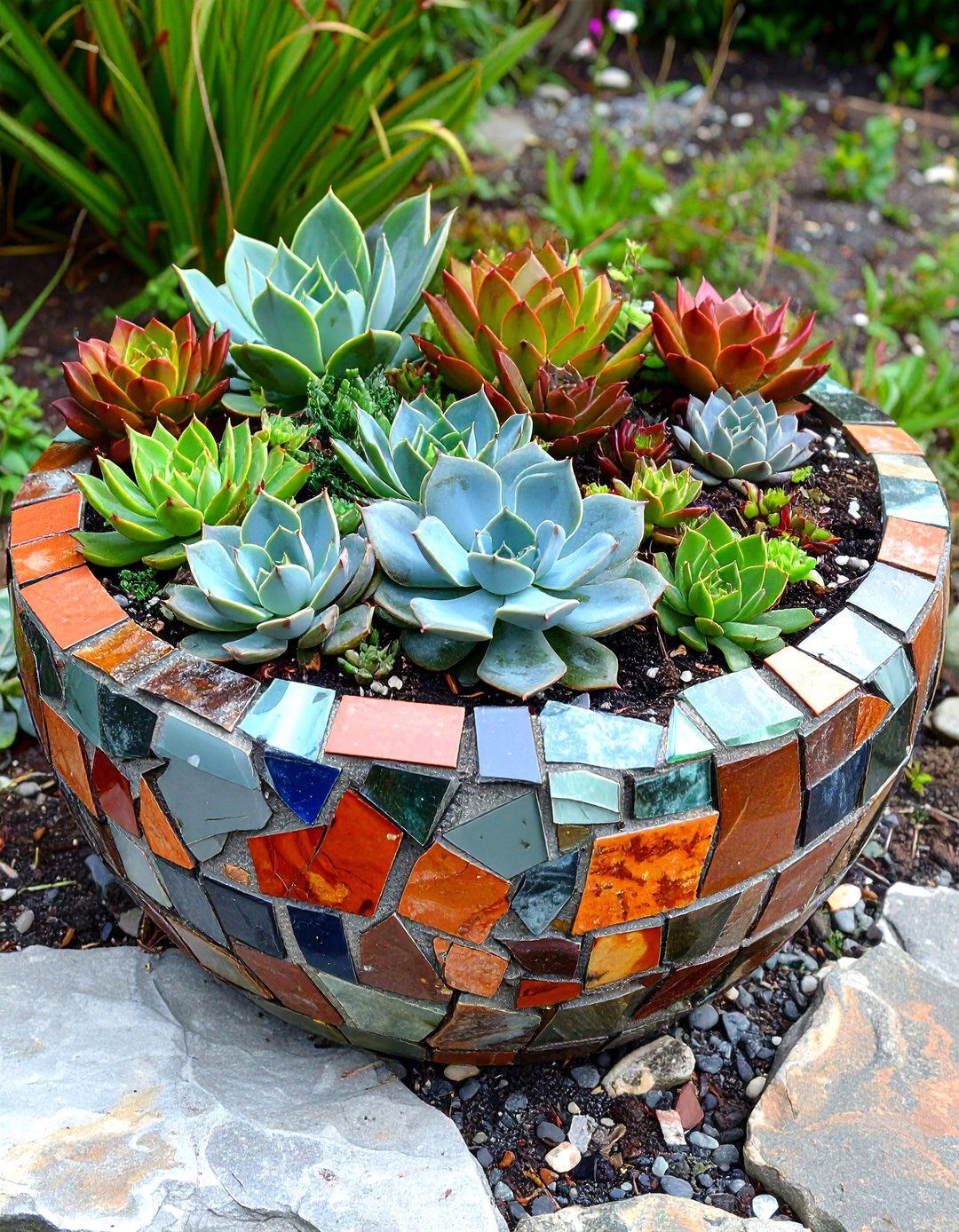
Mosaic planters combine broken tiles, glass shards, and stones to create vibrant vessels for succulents. Line the interior of a sturdy planter, then adhere decorative pieces around its exterior. Once sealed, fill with soil and plant hardy succulents like sedums and haworthias. The contrast between smooth succulents and rough mosaic surfaces adds visual drama. You can also create ground mosaics—patterns laid into patio slabs with succulents filling grout lines—for a permanent artistic statement.
12. Succulent Tables

“Living” succulent tabletops embed shallow trays of succulents under glass or in recessed surfaces. Use hardy, low-growing species—sedum spurium, haworthia, and kalanchoe—for durability. Ensure the table frame supports weight and allows drainage. Terrarium-style glass tops protect plants while offering easy viewing. These tables become conversation pieces in lounges or sunrooms, combining function and living décor. Regular hovering retains moisture, and supplemental grow lights can extend use into dimmer interiors.
13. Succulent Topiaries

Topiary-style succulents use wire frames filled with sphagnum moss to shape trailing succulents into balls or cones. Over time, cuttings of sedum morganianum, crassula muscosa, and euphorbias root within the frame, creating living sculptures. These hanging or freestanding forms sway gently in breezes, adding motion. They require bright, indirect light and occasional misting to encourage moss retention and root growth. Topiaries are striking in entryways or over patios.
14. Succulent Border Gardens
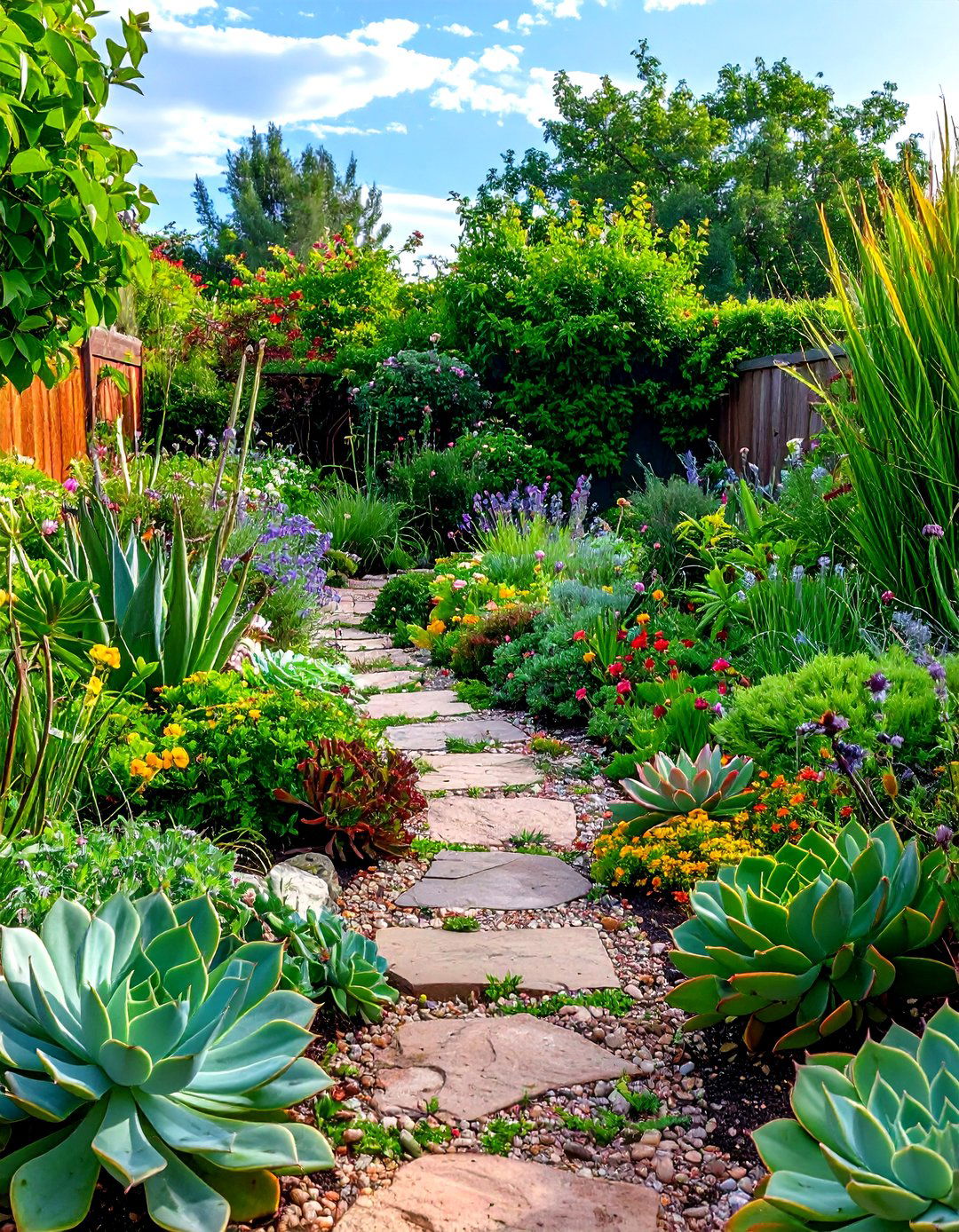
Define pathways or garden edges with low-growing succulents—sempervivums, sedum album, and echeveria minima. Their rosettes form tight mats that suppress weeds and tolerate foot traffic. For a contrasting border, mix variegated and solid-colored varieties, alternating groups for visual cadence. Edging succulents require minimal fertilizer and prefer full sun, making them ideal for dividing xeric landscapes from lawn or gravel areas.
15. Crevice Gardens with Succulents
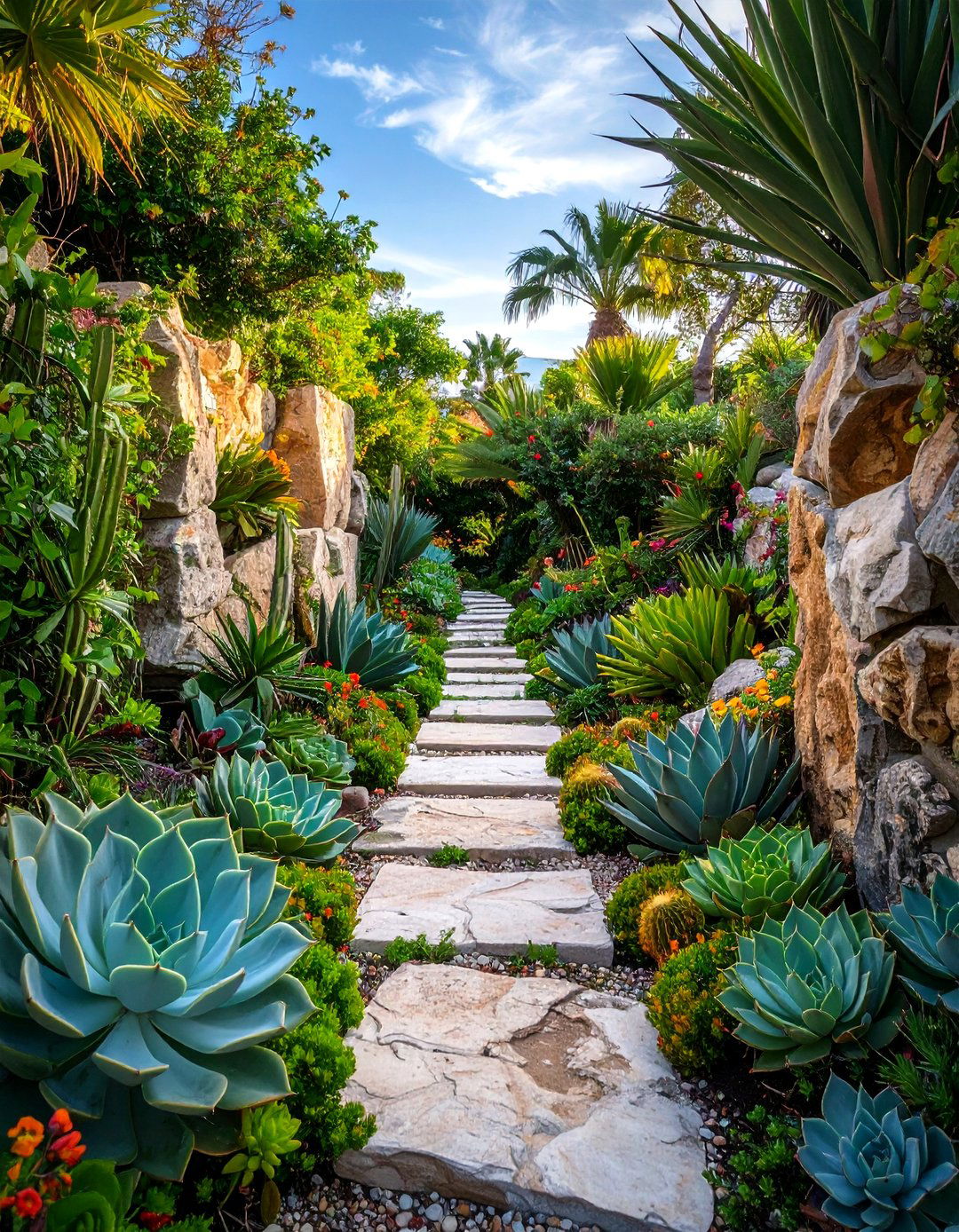
Crevice gardens use upright slabs of sedimentary rock inserted into soil to form planting narrow fissures. Fill these crevices with a grit-based mix, then tuck alpines, succulents, and ferns into the gaps. This method mimics natural cliff habitats and provides excellent drainage. Suitable plants include sedum spurium, sempervivums, and small sempervivums, which root in shallow pockets. Crevice gardens are low-maintenance, visually striking features for rock-laden yards.
16. Succulent Pathways
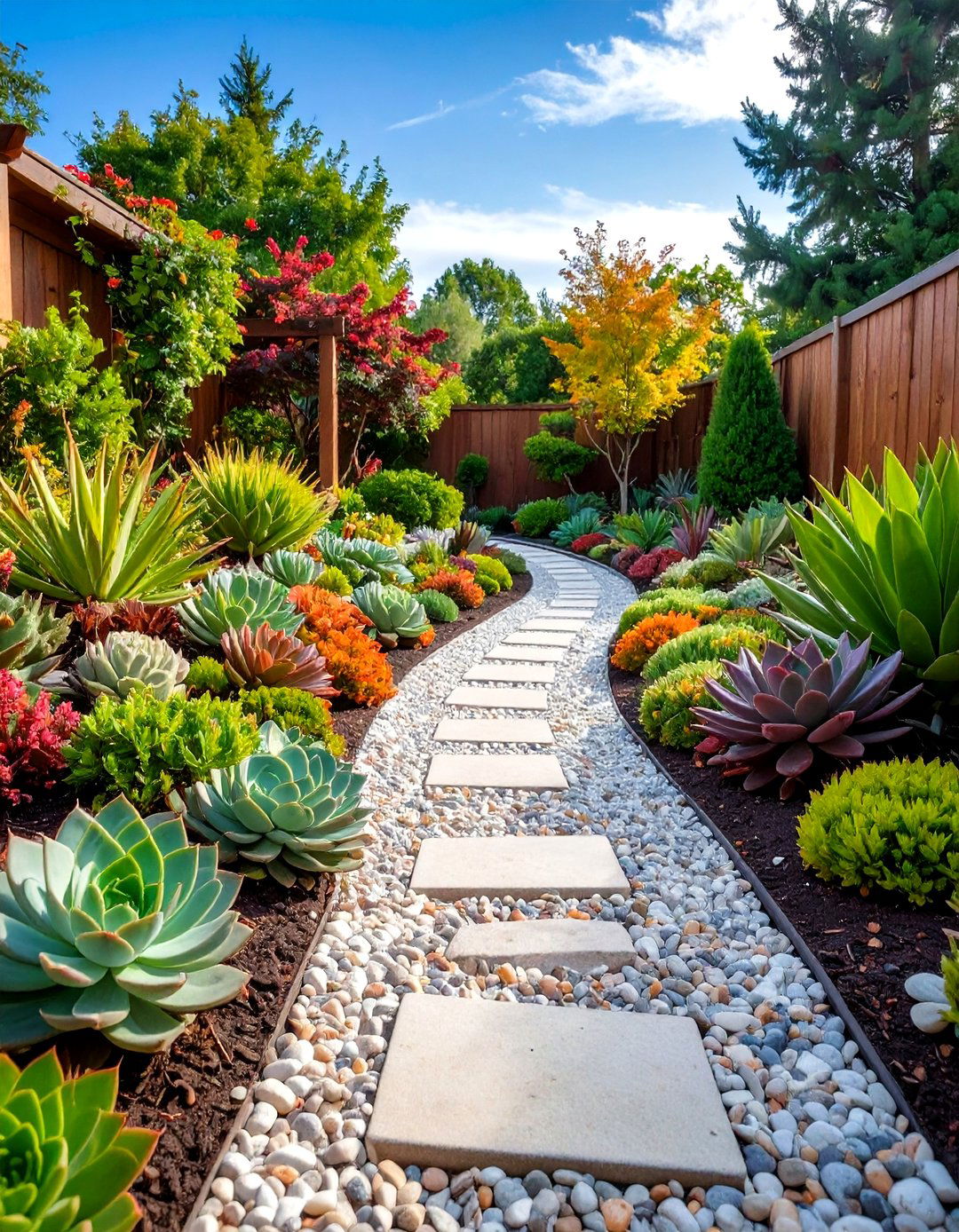
Plant succulents directly into gravel or crushed-stone pathways to soften edges and create living walkways. Use hardy, creeping varieties like sedum acre and sedum reflexum that tolerate intermittent foot traffic. The contrast of green mats against stone pavers highlights both textures, and the succulents’ drought resilience means minimal upkeep. This technique works well for garden stepping stones or patio infill.
17. Pollinator-Friendly Succulent Gardens

Attract bees and butterflies by incorporating flowering succulents such as kalanchoe, aeoniums, and agaves that bloom prolifically. Plant these among groundcover succulents and ornamental grasses, ensuring good air circulation. Native pollinators benefit from late-season blooms when other nectar sources fade. Group flowering succulents together for visual impact and easier pollinator access.
18. Succulent Zen Gardens

Combine succulents with raked gravel, bamboo accents, and stone lanterns to create minimalist Japanese-inspired Zen gardens. Use larger agave or aloe as focal points, surrounded by sedums and sempervivums. The juxtaposition of smooth gravel patterns and sculptural succulents encourages contemplation. This style thrives in dry climates and requires little irrigation.
19. Succulent Porch Gardens

Frame entryways with matching pots of succulents—mixing echeverias, jade plants, and snake plants—for instant curb appeal. Use pairs of tall planters flanking doors or stairs, and hang baskets overhead. Succulents’ hardiness and low water needs make them ideal for seasonal porch displays. Rotate pots for symmetry and refresh foliage seasonally.
20. Showpiece Succulent Exhibits
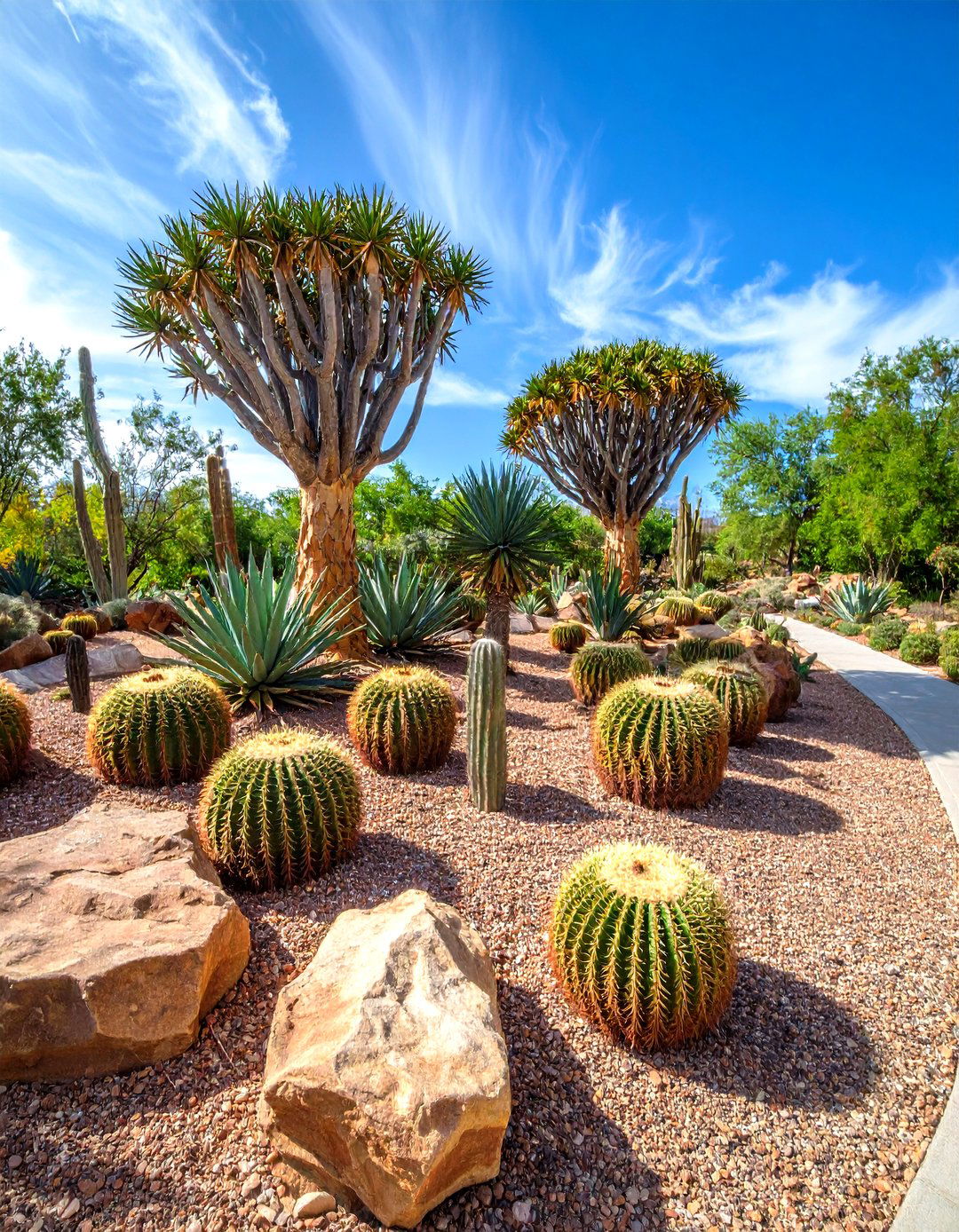
Replicate the grand Karoo Succulent Garden from the 2025 RHS Chelsea Flower Show by curating a large-scale display of rare species—quiver trees, fan aloes, and lithops—grouped by biome. Incorporate sandstone boulders and gravel to emulate semi-desert landscapes. Such an exhibit demands space and specialist care but offers a breathtaking tribute to succulent diversity and resilience.
Conclusion:
Succulent gardens offer unparalleled versatility, from intimate indoor terrariums to expansive outdoor landscapes. By leveraging varied containers, vertical structures, and creative design techniques—such as mosaics, fairy settings, and rock crevices—you can tailor succulent displays to any environment and aesthetic. Their adaptability, minimal water requirements, and sculptural appeal make succulents a sustainable choice for gardeners of all levels. Whether you seek a quiet Zen retreat, a vibrant pollinator haven, or a striking living wall, there’s a succulent garden idea here to inspire your next project.


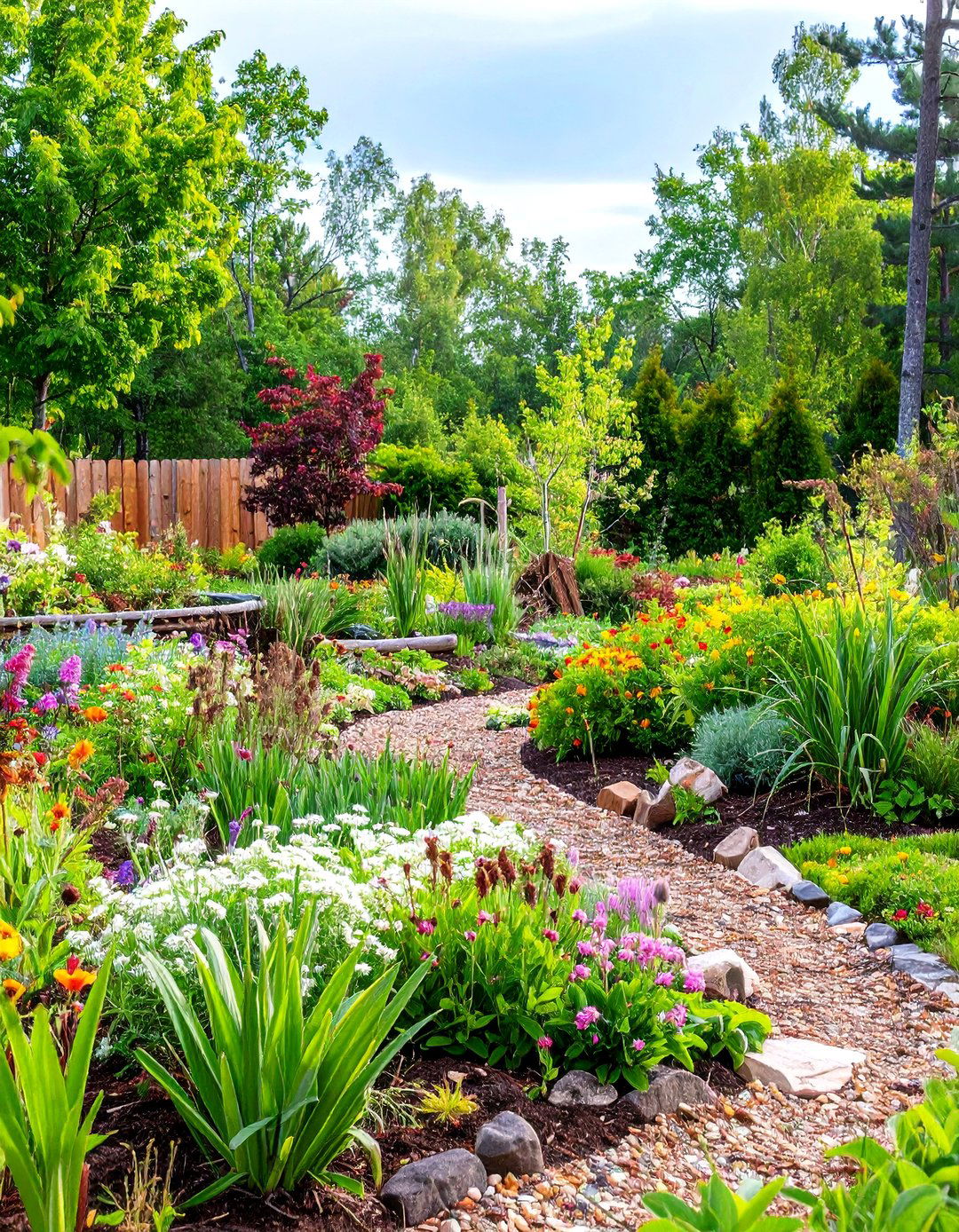
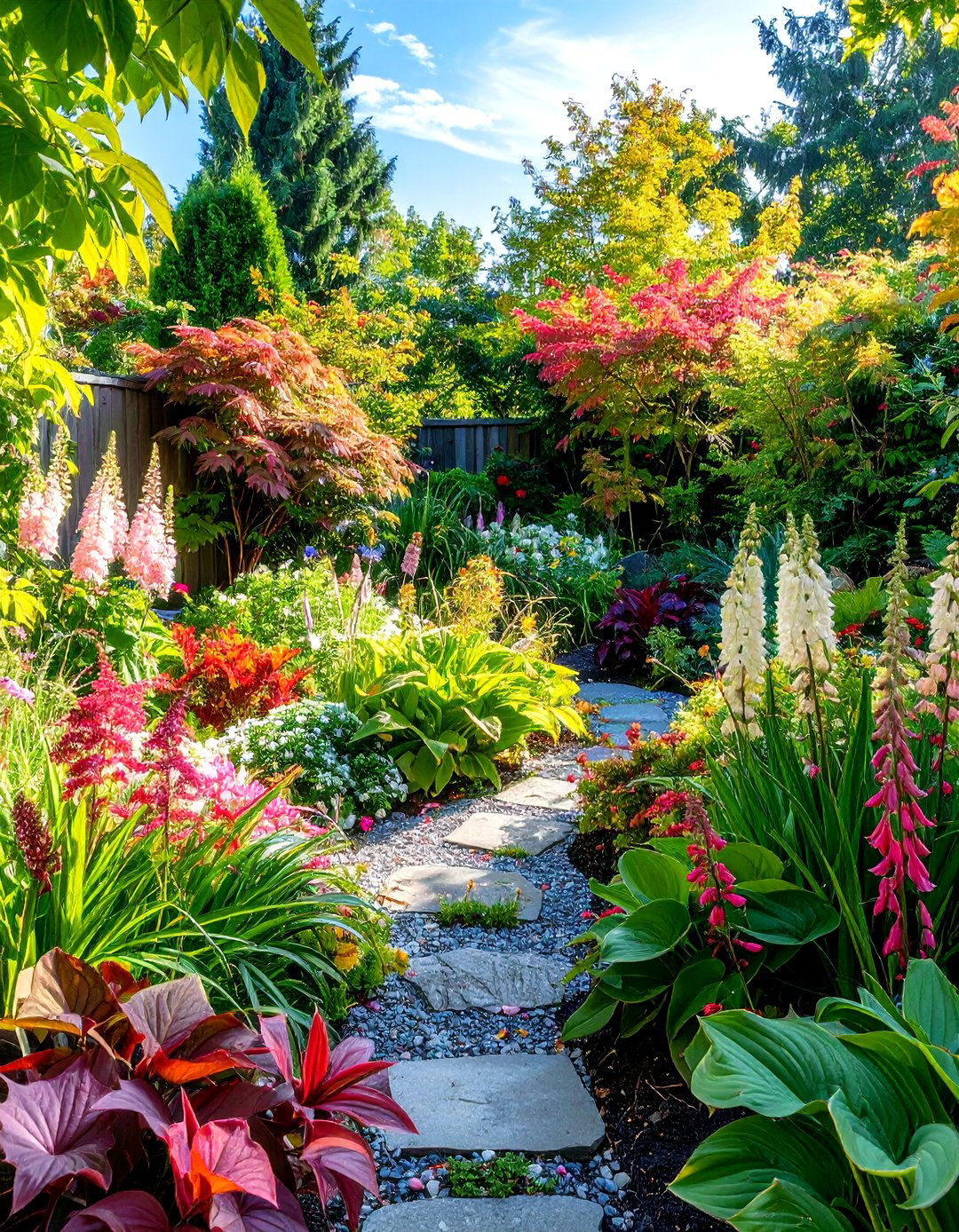
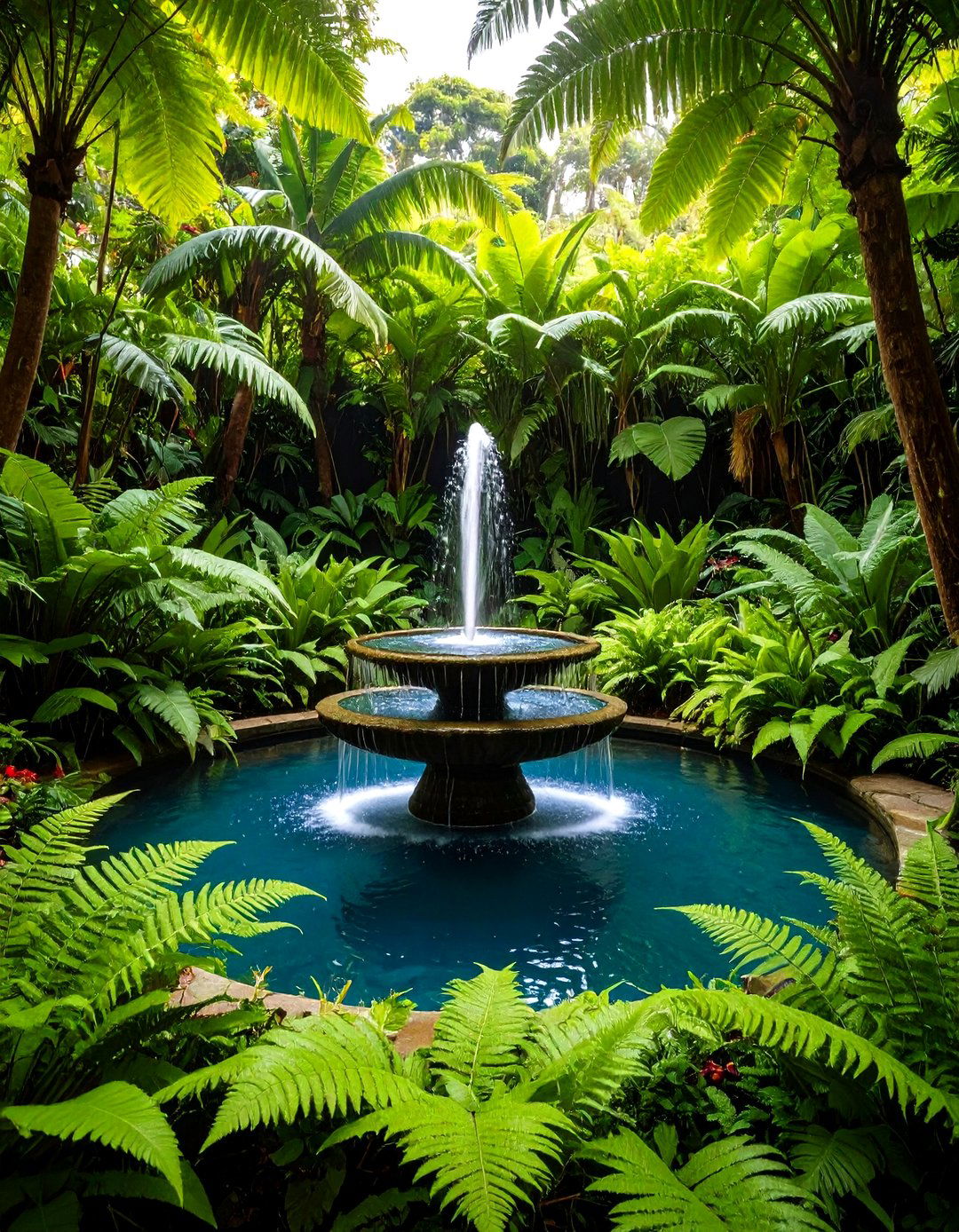


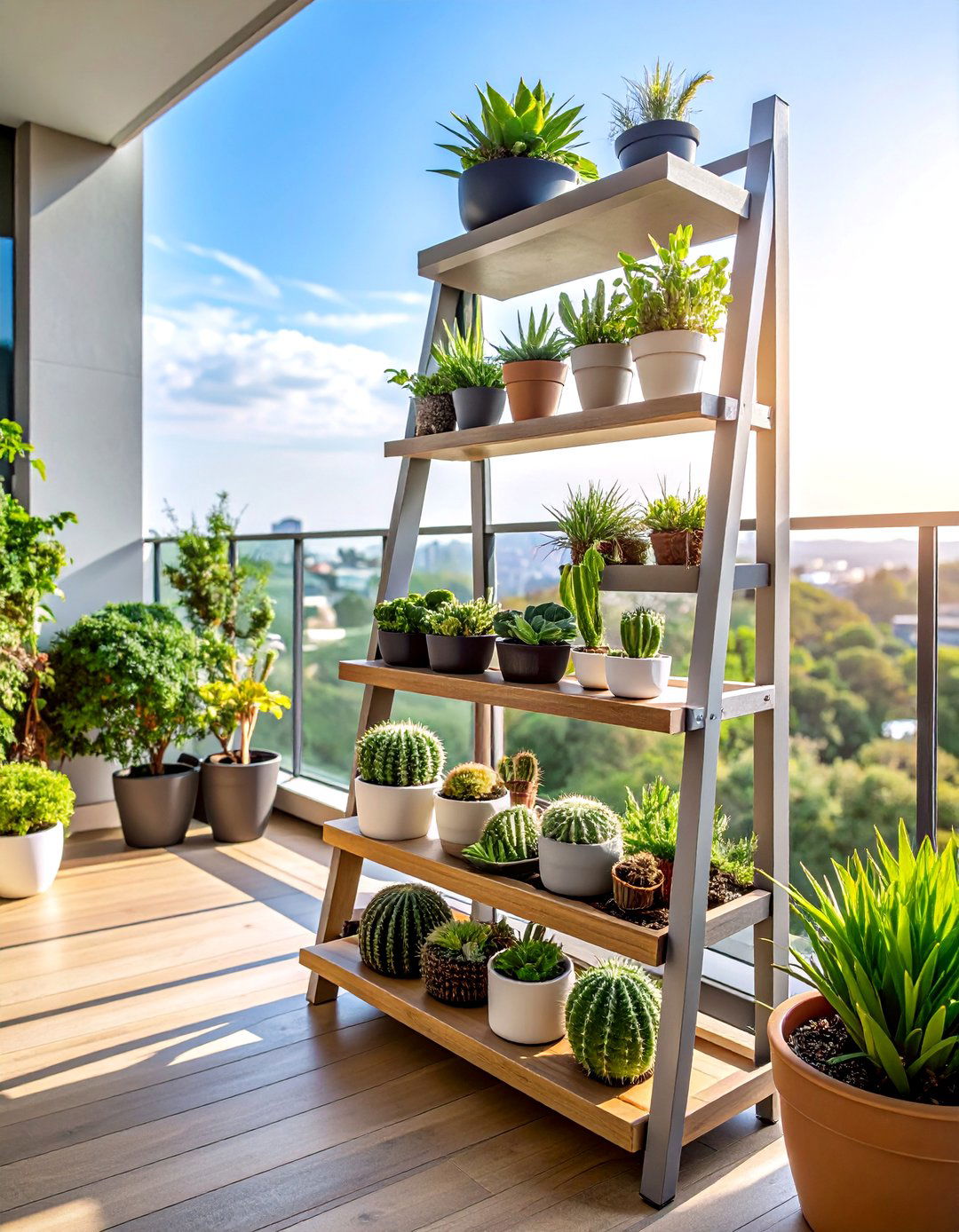
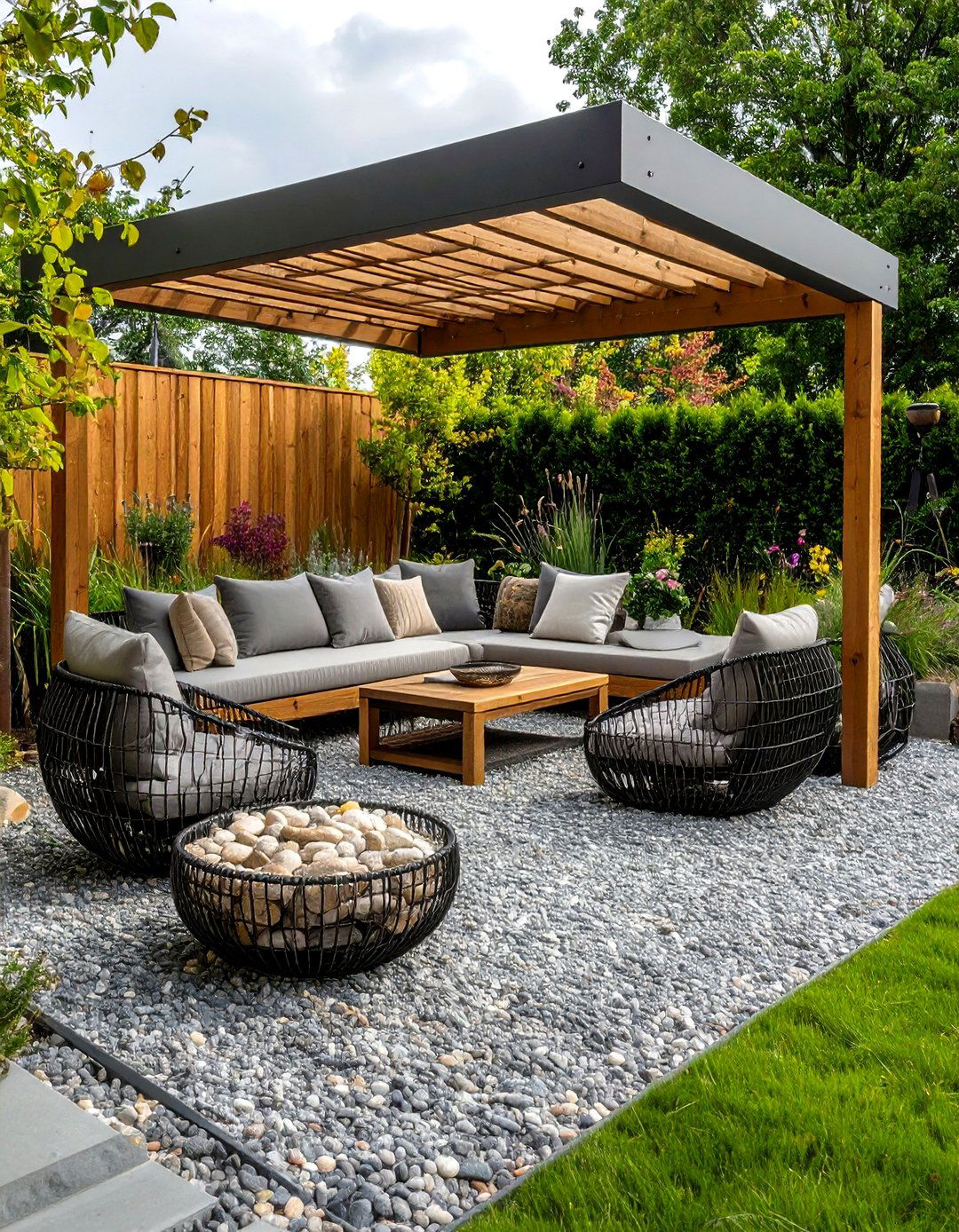
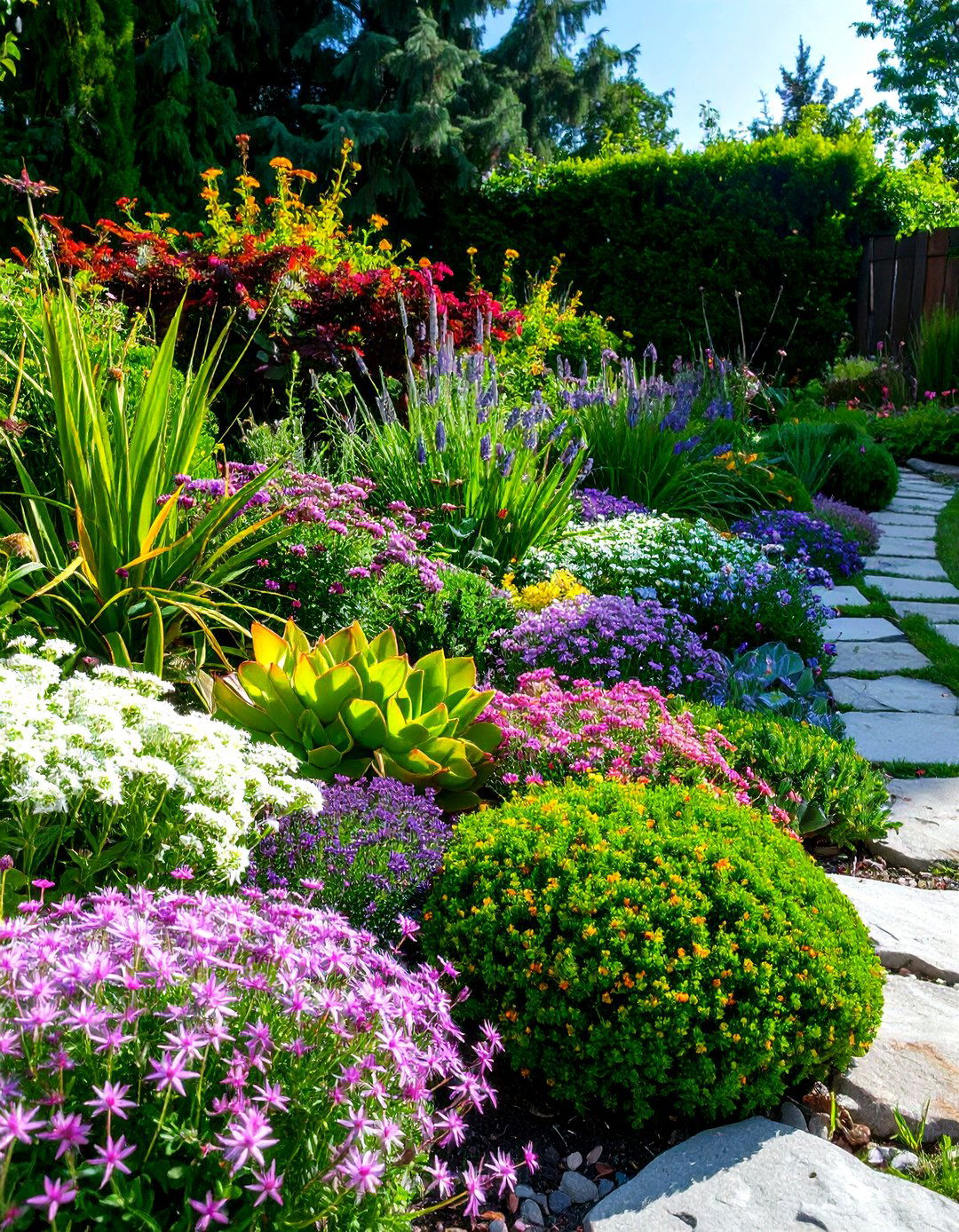

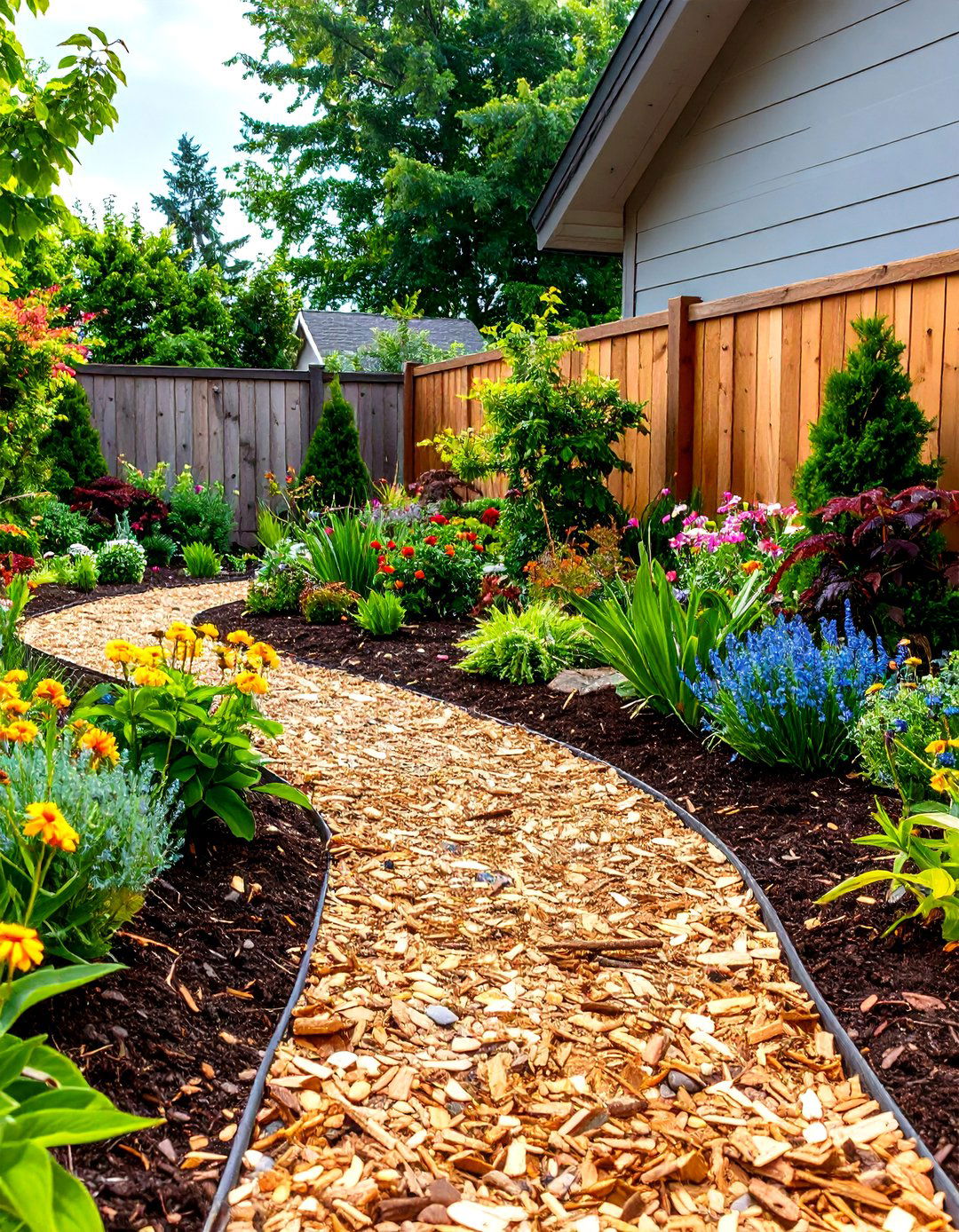
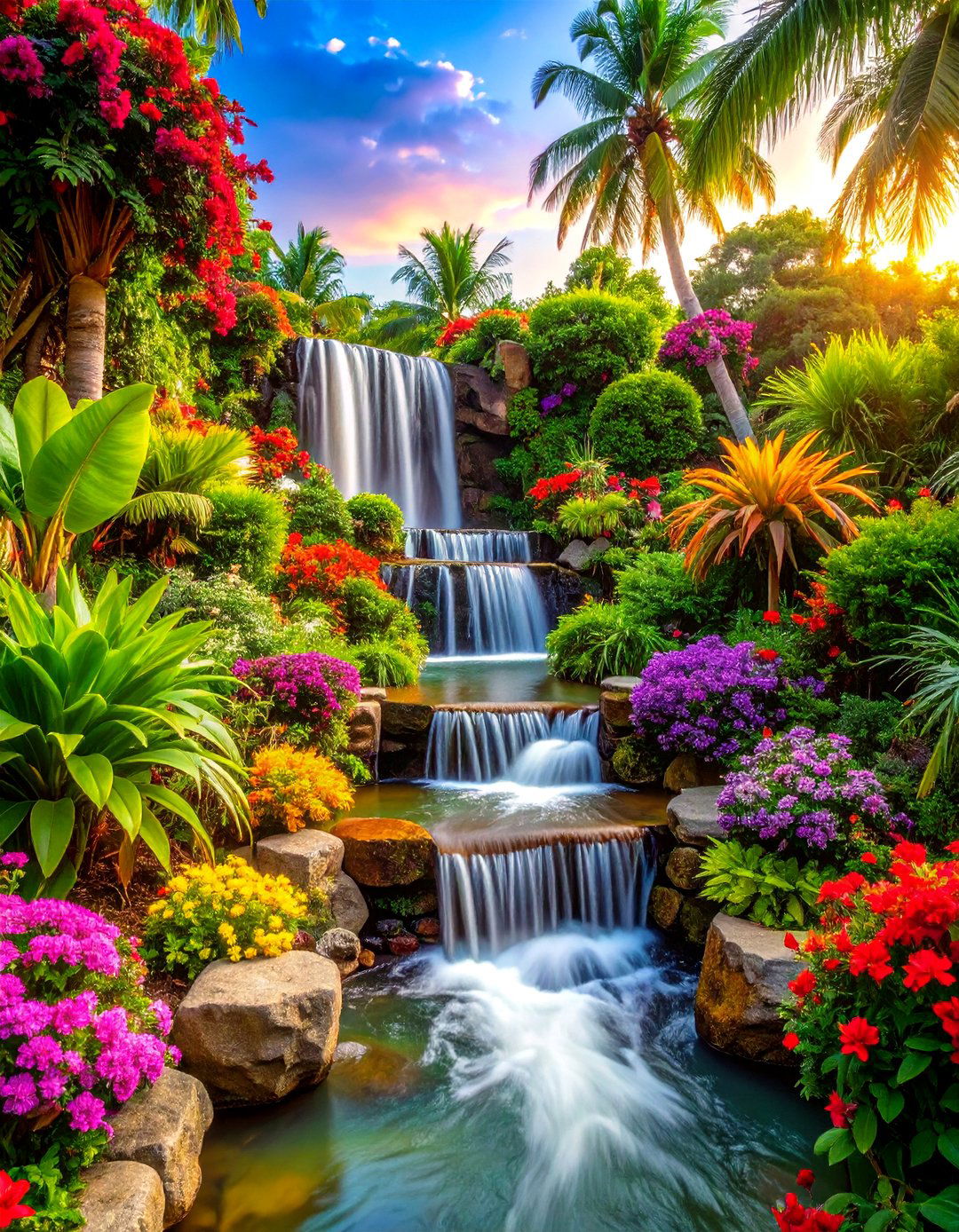

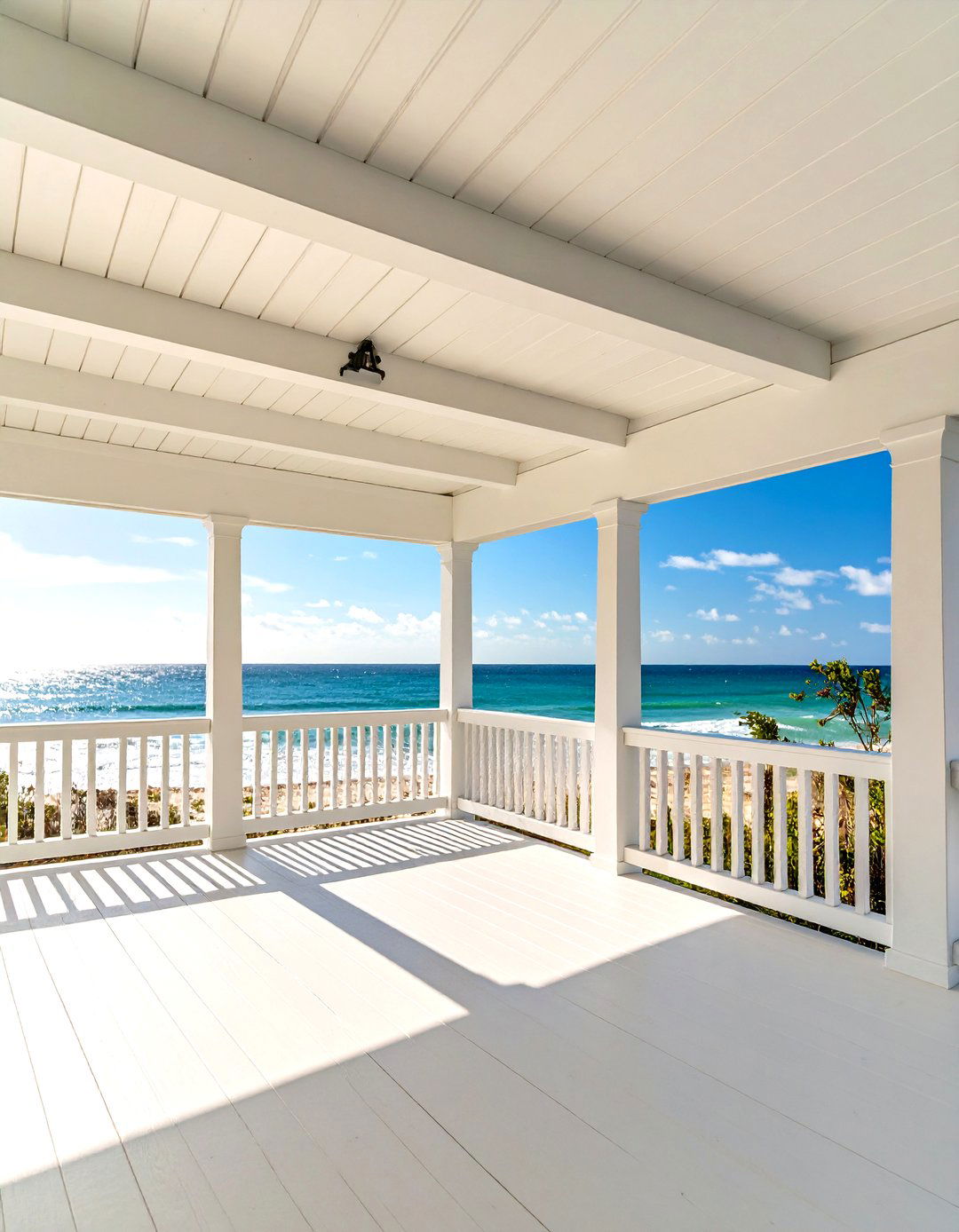
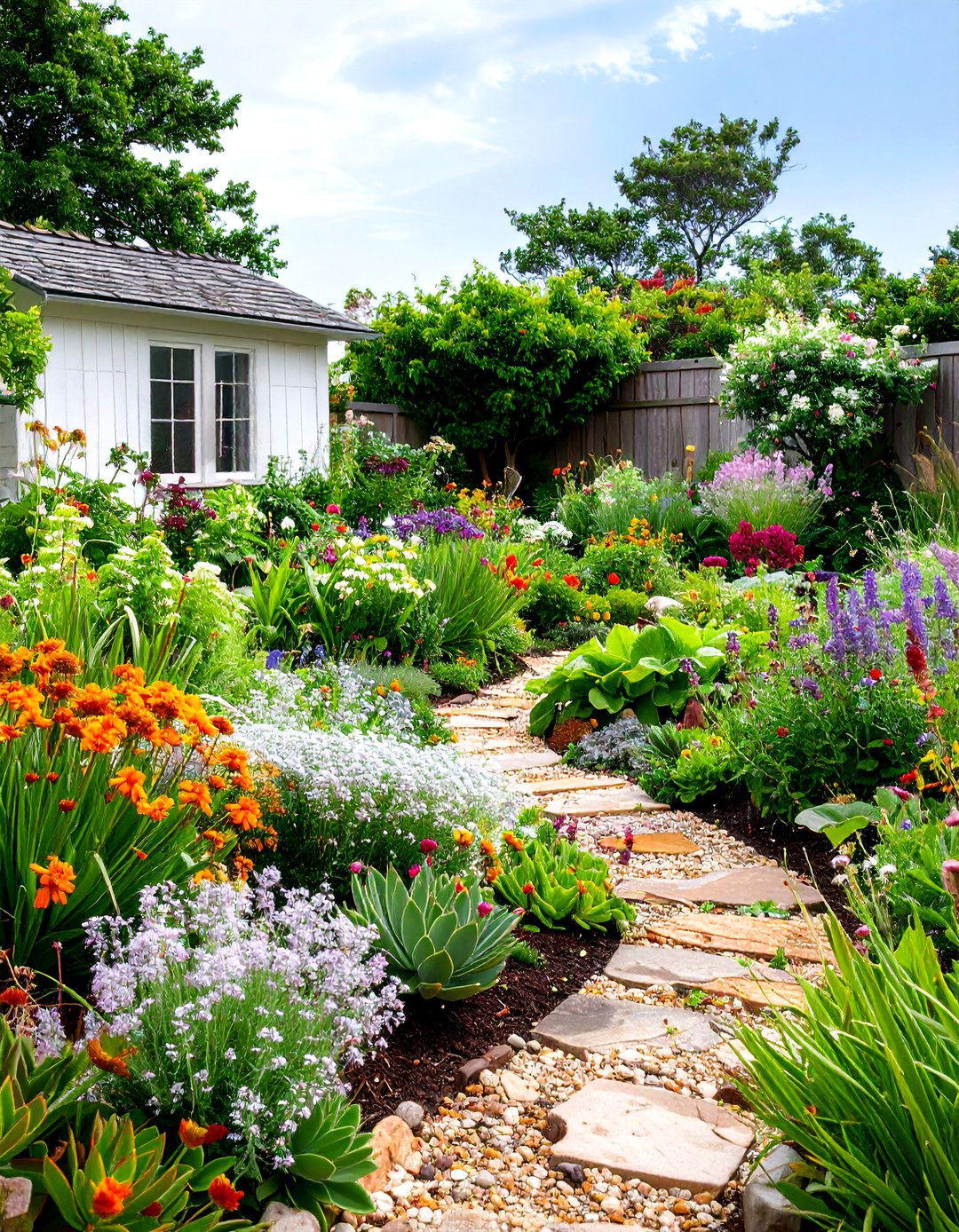

Leave a Reply